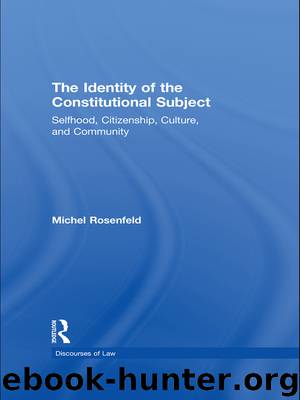The Identity of the Constitutional Subject by Rosenfeld Michel

Author:Rosenfeld, Michel
Language: eng
Format: epub
Tags: Law
Publisher: Taylor & Francis (CAM)
Published: 2009-10-15T16:00:00+00:00
5.5 The Spanish Model
As briefly indicated in Chapter 4, the successful making and implantation of the 1978 Spanish Constitution has given rise to a new constitutional model that differs significantly from the four models discussed thus far. The Spanish Model is distinct in two principal ways. First, it sets a framework for a multi-ethnic polity. And, second, it imports transnational norms, which it incorporated within the ambit of the nation-state.
As discussed in Chapter 4 above, one of the most daunting challenges confronting the making of the 1978 Spanish Constitution was finding a proper balance between national unity and according a meaningful measure of autonomy to ethnic communities, such as the Basque and the Catalans, which had been suppressed ruthlessly during the Franco régime. The Spanish constituents found an ingenious solution that sought to bridge over contentious disputes over national identity – or more precisely, between national and sub-national identities – through masterful use of open-endness and ambiguity. The Spanish Constitution provides for ‘autonomous communities’ (‘communidades autonomas’) with significant, though by no means fully spelled out, regional self-government powers.31 These provisions divide the country into several autonomous communities, affords ethnic groups such as the Basques and the Catalans significant, and to an important degree open-ended, autonomy, but do not limit such available regional autonomy to these well-defined and well-organized ethnic groups. Indeed, the Constitution also extends autonomy to other regions, where infra-national self-government aspirations and organization are much less pronounced. (Moreno 2001).
The practical consequences of this nation-wide division into autonomous communities are, on the one hand, a diffusion of the focus from two most problematic ethnic groups from the standpoint of preservation of national unity, namely the Basques and the Catalans. On the other hand, because regions like Andalusia are in fact autonomous in name only, the 1978 Spanish Constitution creates a de facto type of asymmetrical federalism where all regions are offered significant local autonomy, but only some want to, can, and do take advantage of it. Moreover, this system has worked fairly well for three decades, even if there have been certain difficult moments with potentially momentous constitutional implications, such as the recent tensions between the national government and Catalunia over the latter’s design to greatly increase the scope of it autonomy.32
Although both Spain and the U.S. are multi-ethnic societies, the Spanish constitutional model is multi-ethnic whereas the American one is not. That is because through constitutional accommodation of sub-national ethnic groups, the Spanish Model is suitable for a multi-ethnic polity. In contrast, the American Constitution and the American Model are compatible with a multi-ethnic society, but not with a multi-ethnic polity. Under the Spanish Model, constitutional identity is predicated on striking a balance between national identity and unity and a significant though loosely defined measure of sub-national ethnic identities. American constitutional identity with its heavy emphasis on individualism and on the country as a melting pot designed for the equal enjoyment of constitutional blessings, for its part, leaves little room for ethnic identities within its constitutional landscape.
The second
Download
This site does not store any files on its server. We only index and link to content provided by other sites. Please contact the content providers to delete copyright contents if any and email us, we'll remove relevant links or contents immediately.
The Secret History by Donna Tartt(18948)
The Social Justice Warrior Handbook by Lisa De Pasquale(12168)
Thirteen Reasons Why by Jay Asher(8847)
This Is How You Lose Her by Junot Diaz(6835)
Weapons of Math Destruction by Cathy O'Neil(6219)
Zero to One by Peter Thiel(5735)
Beartown by Fredrik Backman(5681)
The Myth of the Strong Leader by Archie Brown(5458)
The Fire Next Time by James Baldwin(5385)
How Democracies Die by Steven Levitsky & Daniel Ziblatt(5173)
Promise Me, Dad by Joe Biden(5113)
Stone's Rules by Roger Stone(5052)
A Higher Loyalty: Truth, Lies, and Leadership by James Comey(4907)
100 Deadly Skills by Clint Emerson(4882)
Rise and Kill First by Ronen Bergman(4741)
Secrecy World by Jake Bernstein(4701)
The David Icke Guide to the Global Conspiracy (and how to end it) by David Icke(4657)
The Farm by Tom Rob Smith(4466)
The Doomsday Machine by Daniel Ellsberg(4451)
